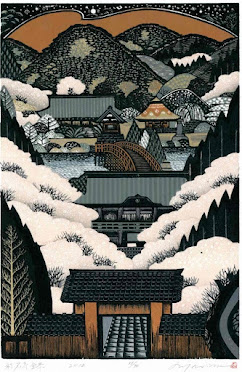Ray Morimura (born 1948) studied oil painting in college but then switched to color woodblock prints that "show traditional Japan through his own lens." I haven't found an explanation of why but you have to think that needing to make a living was part of it. People around the world love and buy Japanese prints with traditional themes, but there isn't much of a market for Japanese oil paintings. I'm certainly happy to have these in the world. Above,
Shinsenen, 2019.
Garden of Kikyo, 2022
Panoramic View of Shomyouji, 2012
Here's something a little different,
Plover. Morimura has done a lot of these sketchy, humorous works as well as the more formal compositions.
Sando, the Approach to the Shrine, 1991
Itsukushima Shrine, Miyajima Island, 2006
Cherry Blossoms in the Moonlight, 1999. Below, a brightly colored work I found posted without title or date.








Ray Morimura (born 1948) studied oil painting in college but then switched to color woodblock prints that "show traditional Japan through his own lens." I haven't found an explanation of why but you have to think that needing to make a living was part of it. People around the world love and buy Japanese prints with traditional themes, but there isn't much of a market for Japanese oil paintings. I'm certainly happy to have these in the world.
ReplyDeleteSomeone born in 1948 would presumably have been in college roughly between 1966 and 1970 - a time when not only was the "post-war economic miracle" was in full swing, but Japan was also ascendant culturally on an international scale. I absolutely believe that a young artist heading into the 1970s would be drawn to traditional artforms over Western painting techniques, both for practical AND aesthetic reasons - traditional Japanese are was trendy, after all, popular in its own right, and then profitable because of that popularity.